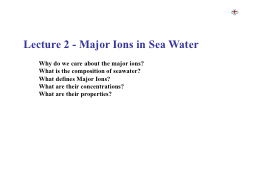

Why do we care about the major ions What is the composition of seawater What defines Major Ions What are their concentrations What are their properties Density distributions and controls salinity and temperature ID: 1036068
Download Presentation The PPT/PDF document "Lecture 2 - Major Ions in Sea Water" is the property of its rightful owner. Permission is granted to download and print the materials on this web site for personal, non-commercial use only, and to display it on your personal computer provided you do not modify the materials and that you retain all copyright notices contained in the materials. By downloading content from our website, you accept the terms of this agreement.
1. Lecture 2 - Major Ions in Sea WaterWhy do we care about the major ions?What is the composition of seawater?What defines Major Ions? What are their concentrations?What are their properties?
2. Density: distributions and controls (salinity and temperature)
3. Density of SeawaterσWhat is salinity? What are and σ? What are their units?σ = (ρ - 1) 1000if ρ = 1.0250 gm/cm3then σ = 25.0σ as S σ as T Q. Why?
4. Q. How is salinity measured? 1. gravimetric 2. analyze all the ions and sum 3. relative to halogens (Cl- + Br- + I-) using Knudsen equation from 1911 (n = 9 samples) S ‰ = 0.030 + 1.8059 Cl ‰ (or gms per kg)4. Conductivity UNESCO, 1981 Defined the Practical Salinity Scale (PSS)See Millero 1993S = 35.000 (don’t use units like PSU)
5. Waters will move mostly along surfaces of constant density.Surface density, isopycnal outcrops
6. Sea Surface SalinityQ. Why does surface salinity vary? DS = 30 to 37What are broad patterns and what controls salinity?
7. Evaporation and Precipitation Effects on Surface SalinityAll original salinity signatures acquired at the sea surfaceModified in the ocean interior by mixing.Becomes tracers for water masses.
8. Salinity Cross Section in Altantic Ocean
9. Salinity Cross Section (Pacific Ocean)
10. Sea Surface Temperature – Annual Average
11. How are the major ions of seawater defined?What are the major ions?Elements versus species?moles versus grams – conversions (See E&H Table 1.2)
12. How are the major ions of seawater defined? ans: major ions contribute to salinity (e.g. 35.000‰ ) salinity can be determined to 0.001 ppt = 1 ppm = 1 mg kg-1Elements versus species? e.g., Na is an element Na+ is a species (cation) S is an element SO42- is a species (anion)What are the major ions? n = 11 ans: cations = Na+ > Mg2+ > Ca2+ ~ K+ > Sr2+ anions = Cl- >> SO42- > HCO3- > Br- > F- neutral = B(OH)3° written as main speciesmoles versus grams – conversions (See E&H Table 1.2) 1 mol = 6.02 x 1023 atoms mol kg-1 = g(solute)/kg (water) g(solute)/mol. wt. 1 mol NaCl = 1 mol Na+ + 1 mol Cl-
13. Concentrationsmolar (M) mol / ltr H2Omolal mol / kg H2OSW mol / kg SW (H2O + salt)Q Why??molmmol 10-3mmol 10-6nmol 10-9pmol 10-12 (Q How many atoms?)
14. Example:We want to make a solution with Na+ = 468.96 mmol/kgfrom NaCl (table salt)
15. DICLiverpool and NIOSi and gasesUnitscationsNa+ > Mg2+ > Ca2+ > K+> Sr2+anionsCl- >>SO42- >HCO3-> Br->F-B(OH)3From PilsonQ. mol balanceQ. charge balance
16. What are the properties of the major ions?
17. Some major ions are conservative. These are Na+, K+, Cl-, SO42-, Br-, B(OH)3 and F-.What does this mean? conservative.Q. How do you demonstrate this?What are the consequences?Do conservative major ions have a constant concentration in the ocean? QLaw of Constant Proportions (major ion/S‰ = constant) Knudsen equation ( S = 0.030 + 1.8050 Cl‰) More recently (S‰ = 1.8065 Cl‰)The Law breaks down in estuaries, evaporite basins, hydrothermal vents. Q
18. Some Major Ions are non-conservativeExamples:Ca2+, Mg2+, Sr2+, Dissolved Inorganic Carbon (HCO3-)Non-conservative behavior due to: biological production hydrothermal ridge crest solutions river water (as in estuaries)
19. Superposition of vertical biological flux on horizontal circulationResults in low surface water and highdeep water concentrations.Results in higher concentrations inthe older deep Pacific than the younger deep AtlanticNutrient Like Profiles
20. Example: Comparison of vertical profiles of nutrients from the Atlantic and PacificPO4SiShallow remineralizationSoft partsDeep remineralizationHard parts
21. Calcium (Ca)Ca = 0.1 / 10.2 = +1.0 % with depthWhy??CaCO3 (s) = Ca2+ + CO32-(from de Villiers, 1999)Non-Conservative Major Elements
22. Sr – also increases with depth (~2%) and N. Atl to N. PacDistributions similar to PO4 (excellent correlation)
23. Acantharia shell and cystExamples from sediment traps at BermudaAcantharia are marine planktonicprotozoansBut why? The mineral phase Celestite (SrSO4) produced by Acanthariaprotozoa is proposed as the transport phase.
24. Inverse Mg – Ca Relationshipfrom EPR at 17S; 113W(from de Villiers, 1999)Note significant variability in Mg(normalized to S = 35)!In this case ~1% variability.Hydrothermal Origin??
25. MgAlkBlack Smoker Fluids, East Pacific Rise , from Von Damm et al., (1985)Ca
26. River water ≠ seawater HCO3- > Cl- Ca2+ > Na+
27. Example of using seawater ratios:From Christner et al (2014) Nature, 512, 310 “A microbial ecosystem beneath the West Antarctic ice sheet”Crustal and seawater components to Subglacial Lake Whillans (SLW) watersThe weathering products probably came from sulfide oxidation, carbonation reactions,and carbonate dissolution.
28.